Team:Cambridge-JIC/OpenHardwareRevolution
The Open Hardware Revolution
In choosing the novel Hardware Track, this years’ Cambridge-JIC iGEM team has come across unexpected challenges. Unsurprisingly perhaps, these have often required us to look into fields of work that we have had little or no previous experience in. This has been particularly true when navigating the world of intellectual property law, including hardware licensing and design copyright. In developing Open Source Hardware (OSH) as part of the competition, we recognised the need for an easily-digestible, comprehensive and hardware-specific guide to ensuring the OSH is accessible to the community.
As part of our human practices effort, we have developed an online tool to guide future iGEM teams through the thought process required when deciding on a license for their own hardware project. We have covered the major license types, and provided information about their key features.
If you’re having trouble understanding the legal or technical jargon, check out the Glossary of Terms. An offline version of this page is also available in PDF form for you to download.
Want to find out more about OSH licensing? Answer the questions below to find out what would be most appropriate for your project.
Please note that this page is not intended as a legal guide, and the authors are not IP-law experts. For legal advice, seek a trained professional. In addition, this page does not cover all licensing options available and is merely a summary of the key elements.
Find the License for your Project
Open Source Hardware
The Cambridge-JIC team is looking to make our product as accessible as possible. This means making our microscope open-source. According to the Open-Source Hardware Association (OSHWA), this means it “is hardware whose design is made publicly available so that anyone can study, modify, distribute, make, and sell the design or hardware based on that design” [1]. This not only requires well-documented procedures but also clear and simple designs that can be modified by non-experts.
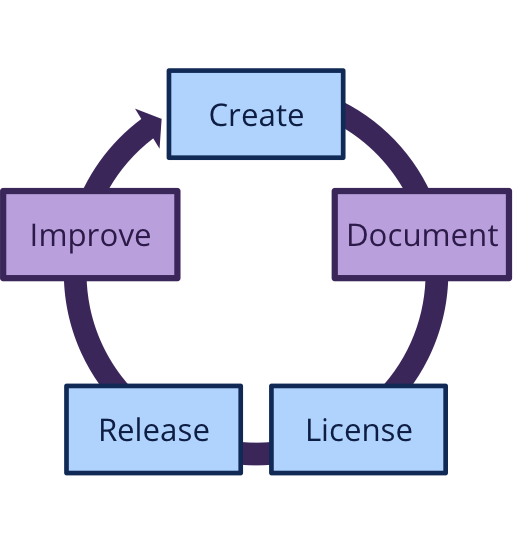
An overview of the OSH evolution cycle. In a viral license system, the license is the same in each cycle.
The advantages of OSH:
The core values reflect the power of collaboration in troubleshooting and improving designs.
Improvements are shared to all users of the hardware, and it can remain freely available forever.
Scientific experiments have different requirements in terms of software and hardware. OSH can address the need for low-volume production of equipment that can be tailored to specific protocols [2].
The OSH revolution extends much further than scientific hardware, and is fully compatible with a commercial business plan. Universally, it has the potential for “market expansion, innovation, acceleration, educational enhancement and medical care improvement” [2].
OSH is “free as in free speech, not free beer” or more formally Libre rather than Gratis [3]. For example, the Arduino microcontroller* designs are freely available online but the foundation also sells them for a profit for funding. Arduino is registered as a trademark too, which protects the brand from cheap, low-quality replicas [4].
* According to arduino.cc “Arduino is an open-source prototyping platform based on easy-to-use hardware and software”. In our project, we use Arduinos to control servo motors and LEDs within the microscope.
[1] Open-source Hardware Association, (2012). Open-Source Hardware FAQ. [online] [Accessed 23 Aug. 2015].
[2] Pearce, J. (2012). Building Research Equipment with Free, Open-Source Hardware. Science, 337(6100), pp.1303-1304.
[3] Gnu.org, (2015). Why Open-source Misses the Point of Free Software - GNU Project - Free Software Foundation. [online] [Accessed 23 Aug. 2015].
[4] Arduino.cc, (2015). Arduino - FAQ . [online] [Accessed 9 Sep. 2015].
Copyleft or Viral Licenses
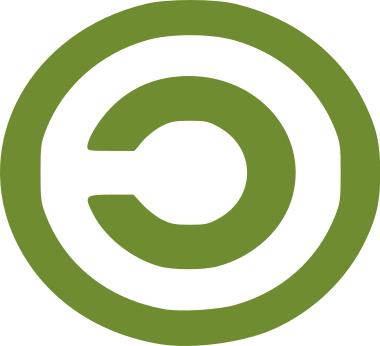
The Copyleft logo. The term was coined by Richard Stallman.
The phenomenon of OSH is in its infancy, and as a result there are only a handful of potential options when choosing an appropriate license. Many of these are Copyleft or ‘viral’ licenses. The principles of Copyleft were developed in the context of Open-Source Software (OSS). A well-established example of a Copyleft OSS licenses is the GNU GPL, but this is not applicable to hardware projects as it is software-specific.
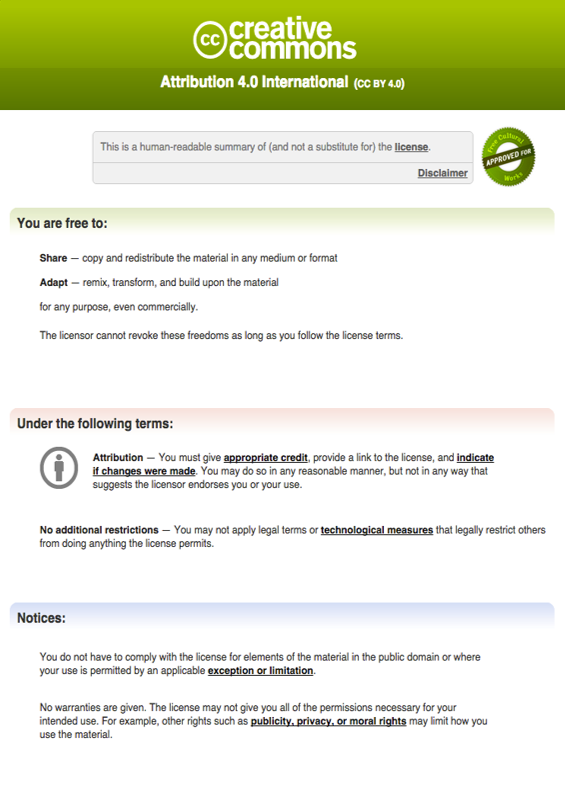
An example of the human-readable version of the most recent Creative Commons Attribution-ShareAlike license (CC BY-SA).
Features of viral licenses:
Any derivatives must be licensed under the same conditions as the original
Once licensed, all derivatives will be fully accessible forever
Reduced likelihood of any derivatives being commercialised compared to Permissive licenses, and no chance of them being made proprietary
Increased issues of license compatibility compared to Permissive licenses. This could be a problem if a new license is released later in time that may be more appropriate
One of the most widespread Copyleft license is the Creative Commons* Attribution-ShareAlike license. This is however not specifically designed for OSH, and was instead developed for copyrighted works such as designs and schematics [1]. More comprehensive and hardware-specific licenses have been created, and here we will focus on two of them: the CERN OHL and the TAPR OHL.
* A global non-profit organisation that enables sharing and reuse of creativity and knowledge through the provision of free legal tools (Creative Commons webpage).
[1] Opensource.com, (2015). What is open hardware? | Opensource.com. [online][Accessed 23 Aug. 2015].
CERN OHL
The CERN OHL was developed to do for hardware what the General Public License (GPL) did for software, and is available for free download*. In 2009, scientists in the community at CERN began to create the Open Hardware Repository: “a place on the web for electronics designers at experimental physics facilities to collaborate on open hardware designs, much in the philosophy of the free software movement” [1]. To complement this, they also developed a hardware-specific license.
The fundamental principals of the CERN OHL are:
If modifications are to be released to the community, they must be under the same license scheme as the original product
This ensures that the license is persistent, and ultimately everyone in the community benefits
The process of improvement uses collaboration between anyone in the community
CERN itself uses the license to release Printed Circuit Boards (PCBs) that it develops back into the physics community. CERN recognised the potentially huge benefit of releasing hardware to the community, where it is effectively peer-reviewed and reconfigured to precisely match end-user requirements [1].
The key features of the CERN OHL are outlined below, as described by the official documentation [1]:
The license covers the distribution of documentation, and the distribution and manufacture of products
The licenses does not extend to code, software or firmware loaded on to electronic devices unless explicitly expressed
The license does not represent the transfer of IP rights to the Licensee
Any modification to the documentation by the Licensee must be clearly noted
The Licensee must distribute all modified documentation under the same, or future versions of the same, OHL
Notable new projects that have taken up the CERN OHL include Adafruit Industries and Citoyens Capteurs, which aims to develop a network of citizen air pollution sensors (amongst other OSH programs) [2].
For more information on CERN licensing procedures, see here.
* See OHWR webpage for more information.
[1] Ayass, M. (2015). CERN Open Hardware Licence. [online] [Accessed 7 Sep. 2015].
[2] Wiki.citoyenscapteurs.net, (2015). Le Wiki des Citoyens Capteurs. [online] [Accessed 12 Aug. 2015].
CERN OHL additional info: CERN documentation requirements
If you create a design that you want to license under the CERN OHL:
Modified documentation must carry prominent notices stating that the Licensee has modified the documentation, with the date and description of the modifications
Documentation must carry a new Documentation Location notice if the original documentation provided for one
Modified documentation must be available at the same level of abstraction as that of the documentation, in the preferred format for making modifications to it (e.g. the native format of the CAD tool as applicable), and in the event that format is proprietary, in a format viewable with a tool licensed under an OSI-approved license if the proprietary tool can create it
The modified documentation must be released under the terms and conditions of this Licence or, where applicable, a later version of this Licence as may be issued by CERN
This is a brief summary. For more detailed information, see the online text of the CERN OHL license v1.2.
TAPR OHL
The TAPR OHL was developed by Tucson Amateur Packet Radio, and like the CERN OHL was created to extend the success of OSS licenses*. It is available for anyone to use, and can be downloaded directly from their website [1]. Just like the CERN OHL it is a Copyleft or ‘viral’ license: the terms applied to one product are propagated to all downstream products. In short, this means that once a product is made open-source, it and all it’s modifications remain accessible to the community.
The key premises of the TAPR OHL are outlined below, as described by the official website [1]:
Products can be used for any legal purpose
Unmodified documentation can be released, but it must be in the form of the entire package
Products can be commercially released as long as the documentation is also freely released, or is available for free for up to 3 years
All modifications must be released under the OHL
All modifications must be well documented, and attempts made to notify the designers of the original product
Overall, the above requirements ensure that nobody is denied the rights to access the product and its documentation, including all downstream versions.
For more information on TAPR licensing procedures, see here.
* It is worth mentioning that these licenses were created by volunteers with expertise in legal matters. They did this for the benefit of the community itself, despite it being a complex and time-consuming process.
[1] Tapr.org, (2015). The TAPR Open Hardware License. [online] [Accessed 23 Aug. 2015].
TAPR OHL additional info: TAPR documentation requirements
If you create a design that you want to license under the OHL, you should [1]:
Include the OHL document in a file named LICENSE.TXT (or LICENSE.PDF) that is included in the documentation package.
If the file format allows, include a notice like "Licensed under the TAPR Open Hardware License (www.tapr.org/OHL)" in each documentation file. While not required, you should also include this notice on printed circuit board artwork and the product itself; if space is limited the notice can be shortened or abbreviated.
Include a copyright notice in each file and on printed circuit board artwork.
If you wish to be notified of modifications that others may make, include your email address in a file named "CONTRIB.TXT" or something similar.
Any time the OHL requires you to make documentation available to others, you must include all the materials you received from the upstream licensors. In addition, if you have modified the documentation:
You must identify the modifications in a text file (preferably named "CHANGES.TXT") that you include with the documentation. That file must also include a statement like "These modifications are licensed under the TAPR Open Hardware License."
You must include any new files you created, including any manufacturing files (such as Gerber files) you create in the course of making products.
You must include both "before" and "after" versions of all files you modified*.
You may include files in proprietary formats, but you must also include open format versions (such as Gerber, ASCII, Postscript, or PDF) if your tools can create them.
* Here it could be easier to link to the original version. Github allows you to do this by “forking” existing repositories to a new one. If you want to contribute back, you can send your changes back by sending a so-called "pull request" back to the original repository as a request to pull your new code into the original repo.
[1] Tapr.org, (2015). The TAPR Open Hardware License. [online] [Accessed 23 Aug. 2015].
Choosing a hardware-specific Copyleft license: CERN or TAPR
Overall, the Copyleft requirements ensure that nobody is denied the rights to access the product and its documentation, including all downstream versions. In this sense the two hardware licenses (CERN and TAPR) are similar. The most significant difference between the TAPR OHL and the CERN OHL is that the TAPR OHL attempts to deal directly with the patent aspect of hardware licensing, and currently is the only license to do so [1]. As mentioned previously, the aspects of hardware such as manufacture and use mean that it is not covered by copyright, and instead must be regulated under patent law*.
This makes the license extremely powerful if the original creator of the hardware patented their creation: they can waive their IP rights under the license and provide full access to products and derivatives. However, a problem arises when the Licensor does not have patent rights over the creation [1]. The cost and complexity of obtaining a patent is a significant obstacle that the creator must attempt to overcome if they want to patent their creation. If anyone else asserts IP rights over the creation under license, and is awarded a patent, then access to the creation is no longer universal under the TAPR OHL.
Ultimately the choice is yours: the TAPR OHL is particularly effective if the patent rights for the original work belong to the licensor, but it also has its drawbacks. As a license TAPR is older, but the CERN OHL has the backing of a strong community of physicists and does not deal as directly with patent rights.
* A reminder: copyright covers creative works such as designs, diagrams, software and other documentation. Patents are applicable to inventions and useful works as physical entities (the finished product).
[1] Keimform.de, (2009). The Tricky Business of "Copylefting" Hardware. [online] [Accessed 10 Sep. 2015]
Permissive Licenses
Features of Permissive licenses:
There are no reciprocity requirements when using a Permissive license. Redistributors can restrict access to derivative products and make them proprietary [1]
Hence they make it more likely that a given product will be repackaged and commercialised [2]
This is seen by some as a driving force for innovation and an additional freedom compared to Copyleft licenses [3]
They are designed to be legally simple and compatible with a greater variety of downstream licenses than Copyleft licenses (see compatibility charts)
It is important to recognise that any improvements on the product that are made proprietary will not be available to the community. This is not a problem with Copyleft licenses.
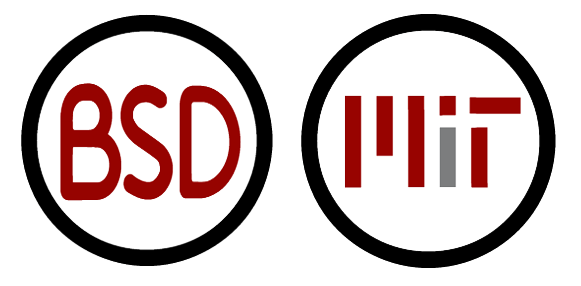
The BSD and MIT license logos. These are widely used and well-established permissive licenses.
A variety of Permissive licenses are available, and recently it has been proposed to develop a new one based on the Apache 2.0 software license as this is already well established [4].
A summary of the licenses available for open source projects:
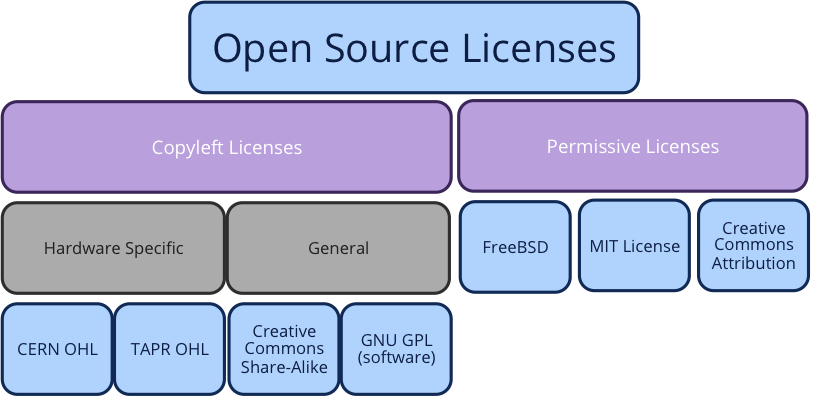
[1] Opensource.org, (2015). Frequently Answered Questions | Open-source Initiative. [online] [Accessed 6 Sep. 2015].
[2] Gnu.org, (2015). Categories of Free and Nonfree Software - GNU Project - Free Software Foundation. [online] [Accessed 6 Sep. 2015].
[3] Opensource.com, (2015). How to choose a license for your open-source project | Opensource.com. [online] [Accessed 6 Sep. 2015].
[4] Katz, A. (2012). Towards a Functional Licence for Open Hardware. IFOSS L. Rev., pp.41-62.
CC0 and Unlicensed Work

The marks for the CC0 license (left) and Public Domain Mark (right) to be displayed on works under these agreements.
The Creative Commons ‘No Rights Reserved license’ (known as the CC0 license) essentially waives all copyrights you have over you work. This means there is no legal protection against you works being used, modified, redistributed or made proprietary. However, your work is now as free to use as it could possibly be. It is often used to release teaching material online, such that as many people as possible can benefit from it.
Under the CC0 anyone can access your work, and use it in any way they want. However, you cannot license the work of other people under the CC0 unless you have express permission to do so or they have also used the CC0 license. This is an example of license compatibility issues (see compatibility tables).
Unlicensed work released into the public domain can be used by anyone in any way, again meaning that continued access cannot be ensured. Creative Commons recommends using the ‘Public Domain Mark’ for this work. This is intended for old works that are already in the public domain without copyright in order to provide information about them [1].
A brief summary to getting a CC license for your designs, software and literature:

[1] Wiki.creativecommons.org, (2015).Frequently Asked Questions - Creative Commons. [online] [Accessed 5 Sep. 2015].
GNU GPL
The GNU General Public License (GPL) is the paradigm for Copyleft licenses. It was developed by Richard Stallman of the Free Software Foundation in the context of Free Open Source Software (FOSS). Here, as with OSH, the reference to ‘free’ is in terms of freedom and not cost.
The license agrees with, and establishes the four essential freedoms of FOSS:
Freedom 0 – the freedom to use the work
Freedom 1 – the freedom to study the work
Freedom 2 – the freedom to copy and share the work with others
Freedom 3 – the freedom to modify the work, and the freedom to distribute modified and therefore derivative works
As a software-specific license, the GNU GPL does not fall within the scope of our project. However, it is worth mentioning that many of the current OSH licenses were developed on the standards of the GPL and in an attempt to achieve what the GPL has in the context of hardware.
For more information about the GNU GPL, visit the GNU webpage.
Compatibility Chart for Licenses
The table below indicates the compatibilities of the Creative Commons licenses with one-another, as described on their website.
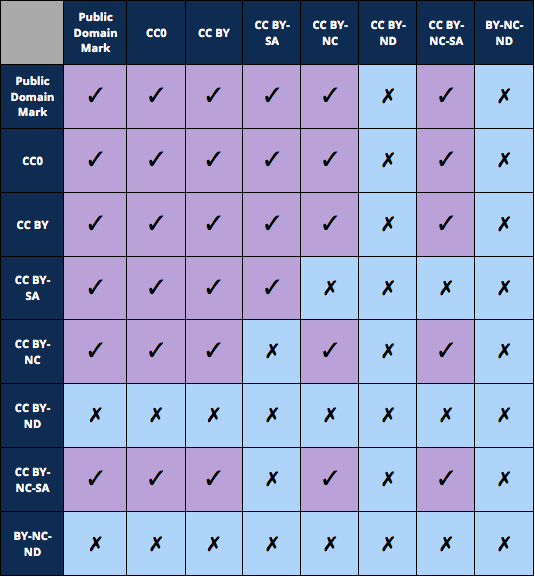
The diagram below indicates the relationships between common OSH licenses, and their categorisation as Permissive/Copyleft. The arrows indicate compatibility in a directional sense. The names in the boxes represent common licenses, and the ‘+’ means ‘and all later versions’. David Wheeler created this graph in the context of OSS, but some of the licenses are applicable to hardware documentation, specifically the MIT and BSD-new licenses. For a clarification of some of the terms, see Glossary.
The CERN OHL and TAPR OHL both stipulate that all documentation (including software) can be licensed under same license. However, alternatively strongly protective Copyleft licenses (see below) are compatible with both of the hardware-specific licenses when considering the code, firmware or software associated with electronic devices in the final product.

Glossary of Terms
Arduino - An open-source prototyping platform based on easy-to-use hardware and software. It is a microcontroller that is programmed through the Arduino software IDE (arduino.cc).
CAD – Computer Aided Design. The use of computer programs to make high precision 2D and 3D designs.
CERN OHL – An open hardware license developed and used by CERN (European Organisation for Nuclear Research) based on Copyleft principles.
Compatibility – An issue that arises when different licenses have conflicting requirements that prevent them from being combined. A particularly common issue with software.
Copyleft – A license type that allows products, designs and software to be released freely for modification, distribution and use. Any derivatives must be licensed under the same conditions.
Copyright – A legal right that gives the creator of a design, artistic work or software exclusive rights to its use and distribution. In most cases they last for a limited amount of time.
Creative Commons - A global non-profit organization that enables sharing and reuse of creativity and knowledge through the provision of free legal tools (CC Wiki).
Git – a revision control system created by Linus Torvalds for the Linux kernel. It allows modifications to be tracked and recorded.
Github – An online Git repository that has a number of additional features to version control such as a graphical interface (github.com).
GPL – General Public License. The most widely used free software license, and the first Copyleft license released for general use.
License – A permit for an activity that would otherwise be illegal. This can include distributing, using or modifying another’s designs or products.
Licensee – A person exercising their rights under the license.
Network Protective – A form of Copyleft license that has provisions for the use of software over a computer network. Code must be made available for people accessing the network.
Open-source - Hardware whose design is made publicly available so that anyone can study, modify, distribute, make, and sell the design or hardware based on that design (OSHWA).
OSHWA – Open-source Hardware Association. An organisation that provides information and best practices for releasing open-source hardware.
Patent – Recognition from the government for an inventor to have exclusive rights to make, use and sell the invention. Usually lasts for a limited amount of time.
PCB – Printed Circuit Board. A board that connects electronics components using conductive tracks on an insulating board.
Permissive License – An open-source hardware license that permits derivatives of the product to be made proprietary.
Proprietary – A product privately owned by an individual or corporation under patent or trademark, and therefore not open to be modified, remixed or redistributed.
Strongly Protective – A form of Copyleft license that adheres to all the standards of the Copyleft principles.
TAPR OHL – An open hardware license developed and used by Tucson Amateur Packet Radio under the principles of Copyleft.
Viral - A pejorative term for Copyleft licenses, referring to Copyleft licensed code ‘infecting’ proprietary software.
Weakly Protective - A form of Copyleft license that has elements of a Permissive license. Computer code cannot be made proprietary, but can be made part of a larger proprietary program.
ABOUT US
We are a team of Cambridge undergraduates, competing in the Hardware track in iGEM 2015.
read moreLOCATION
Department of Plant Sciences,
University of Cambridge
Downing Street
CB2 3EA
CONTACT US
Email: igemcambridge2015@gmail.com
Tel: +447721944314











